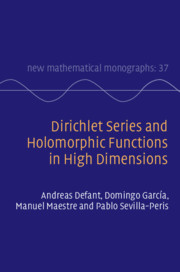Book contents
- Frontmatter
- Contents
- Introduction
- Part 1 Bohr’s Problem and Complex Analysis on Polydiscs
- Part 2 Advanced Toolbox
- 14 Selected Topics on Banach Space Theory
- 15 Infinite Dimensional Holomorphy
- 16 Tensor Products
- 17 Probabilistic Tools II
- Part 3 Replacing Polydiscs by Other Balls
- Part 4 Vector-Valued Aspects
- References
- Symbol Index
- Subject Index
15 - Infinite Dimensional Holomorphy
from Part 2 - Advanced Toolbox
Published online by Cambridge University Press: 19 July 2019
- Frontmatter
- Contents
- Introduction
- Part 1 Bohr’s Problem and Complex Analysis on Polydiscs
- Part 2 Advanced Toolbox
- 14 Selected Topics on Banach Space Theory
- 15 Infinite Dimensional Holomorphy
- 16 Tensor Products
- 17 Probabilistic Tools II
- Part 3 Replacing Polydiscs by Other Balls
- Part 4 Vector-Valued Aspects
- References
- Symbol Index
- Subject Index
Summary
We give an introduction to vector-valued holomorphic functions in Banach spaces, defined through Fréchet differentiability. Every function defined on a Reinhardt domain of a finite-dimensional Banach space is analytic, i.e. can be represented by a monomial series expansion, where the family of coefficients is given through a Cauchy integral formula. Every separate holomorphic (holomorphic on each variable) function is holomorphic. This is Hartogs’ theorem, which is proved using Leja’s polynomial lemma. For infinite-dimensional spaces, homogeneous polynomials are defined as the diagonal of multilinear mappings. A function is holomorphic if and only if it is Gâteaux holomorphic and continuous, if and only if it has representation as a series of homogeneous polynomials (known as Taylor expansion). A function is weak holomorphic if the composition with every functional is holomorphic. A function is holomorphic if and only if it is weak holomorphic. Analytic functions are holomorphic.
Keywords
Information
- Type
- Chapter
- Information
- Dirichlet Series and Holomorphic Functions in High Dimensions , pp. 351 - 409Publisher: Cambridge University PressPrint publication year: 2019
